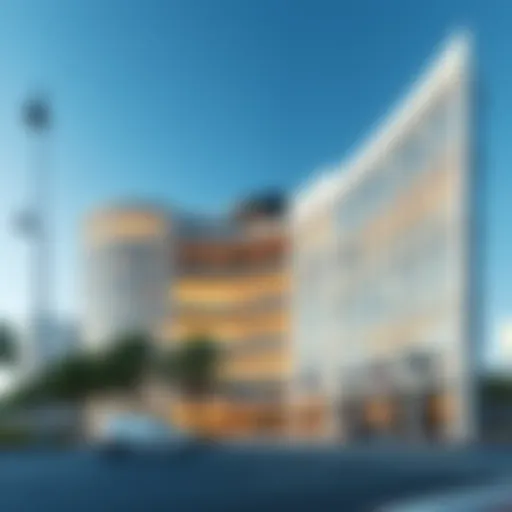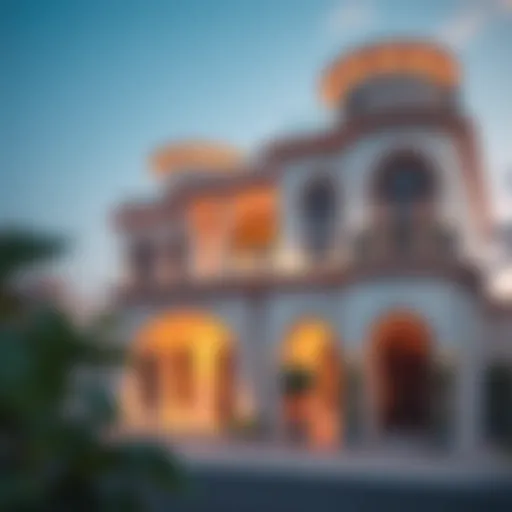Exploring Dubai's Skyscrapers: Architectural Wonders

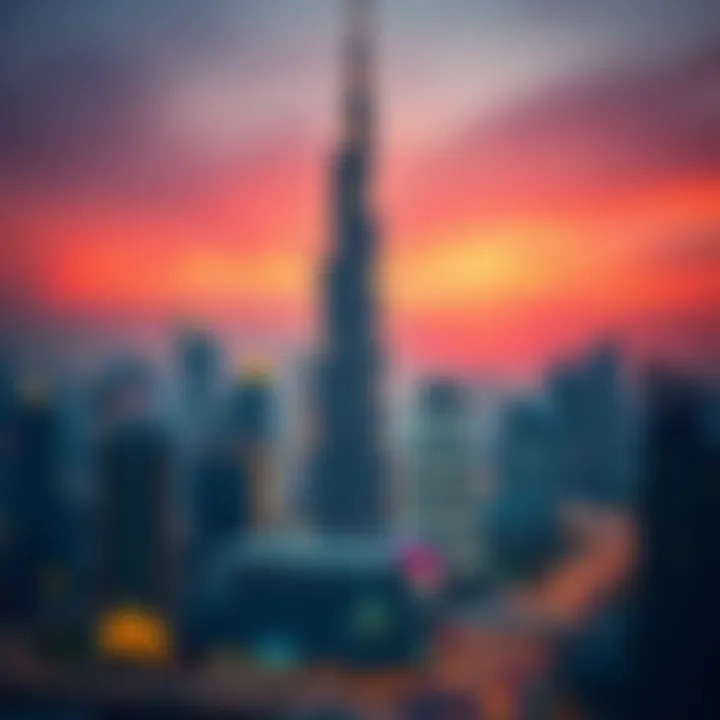
Intro
Dubai is more than just a playground for the wealthy or a glittering oasis in the desert; it stands as a testament to human ingenuity and ambition. The city's skyline, peppered with ambitious skyscrapers, tells a story of rapid growth and architectural brilliance. Ever since the turn of the millennium, Dubai has transformed into a mash-up of bold designs and towering edifices, making it an architectural wonderland that continues to attract global attention.
As you stroll through the streets of Dubai, it's impossible not to notice how these structures not only define the cityscape but also impact the economies surrounding them. From the mesmerizing Burj Khalifa to the futuristic Cactus Tower, each skyscraper contributes uniquely—enhancing property values, attracting tourism, and inviting international investments.
This article aims to unpack various elements surrounding Dubai's skyscrapers. It will explore their architectural significance, evaluate economic influences, and delve into how they shape the urban environment. With much to uncover, this narrative will provide valuable insights dedicated to investors, developers, and all those interested in the city’s evolving landscape.
Preamble to Dubai's Skyscrapers
Dubai is often referred to as the City of Gold, but beyond its valuable resources, it is the towering skyscrapers that truly define its skyline. This section aims to illuminate the intricate dance between architecture and urban development, setting the stage for a flourishing metropolis. The extraordinary growth of Dubai's skyline reflects not only the ambitions of its builders but also the aspirations of its people and the economic landscape of the region.
The rise of these architectural giants is nothing short of a marvel. Each structure, from the resplendent Burj Khalifa to the sleek Emirates Towers, contributes to a cohesive image of innovation and engineering prowess. These skyscrapers represent more than just height; they embody the spirit of a city that continually reinvents itself. Investors and real estate enthusiasts look to these landmarks, recognizing their potential not just as symbols of luxury but as substantial economic assets.
The Architectural Landscape of Dubai
The architectural landscape of Dubai is a tapestry woven from various design influences and cutting-edge technologies. It stands as a beacon attracting the eyes of architects, investors, and tourists alike. Not confined to any single style, Dubai's skyline is an eclectic mix of contemporary and traditional designs. Here, you can find the ultramodern facades of the Burj Khalifa, which pierces the skyline with its futuristic lines, juxtaposed against the uniquely shaped Burj Al Arab, resembling a sail raised against the wind.
Moreover, the incorporation of elements from Islamic architecture highlights Dubai's rich cultural heritage. The design of many buildings includes intricate mosaics and arches, blending modern techniques with traditional aesthetics. This blend fosters an environment that captures the imagination, drawing crowds and capital from around the globe. Every new skyscraper pushes the boundaries of architectural possibility, pushing designers to think outside the box while upholding a distinct identity.
"Dubai's skyscrapers don't just scrape the sky; they redefine what it means to reach for the stars."
The competition among developers has fueled a dynamic architectural environment. The possibilities of the digital age allow for unprecedented heights and innovative materials that were once inconceivable. Night-friendly lighting designs turn the skyline into an illuminated canvas, showcasing the hard work and creativity behind each project.
Importance of Skyscrapers in Urban Development
Skyscrapers play a crucial role in urban development, particularly in a rapidly expanding city like Dubai. As the population swells, the need for efficient use of space surges. High-rise buildings offer a solution to housing and commercial demands without sprawling across vast areas of land, preserving vital green spaces.
From an economic standpoint, these structures are powerhouses. They not only drive up the value of nearby properties but also attract multinational companies, creating hubs of commerce and trade. The influx of businesses bolsters local employment opportunities, encouraging a diverse workforce to flock toward the city.
- Increased Property Values: The presence of iconic skyscrapers can elevate the entire area’s market, driving further investment.
- Sustainable Urban Growth: By concentrating infrastructure vertically, cities can manage resources more efficiently, reducing the overall carbon footprint.
- Cultural Significance: Beyond their economic impact, skyscrapers serve as cultural landmarks, creating a recognizable identity that can foster a sense of pride among residents.
In summary, the skyscrapers of Dubai are more than just architectural feats; they’re pillars of urban development that synergize luxury, sustainability, and economic growth. As the city continues to evolve, these soaring beacons of modernity will remain at the forefront, reflecting both the ambitions of today and the possibilities of tomorrow.
Historical Context
Understanding the historical context of skyscrapers in Dubai is essential to grasp how they have shaped the city and its identity. The evolution of high-rise buildings reflects the rapid transformation of Dubai from a modest trading port to a bustling metropolis known globally for its architectural feats. This section will delve into pivotal moments that contributed to the surge of skyscrapers in the 21st century and the cultural influences that continue to guide their designs, providing insight into the relationship between architecture and the socio-economic landscape.
The Rise of Skyscrapers in the 21st Century
The turn of the century marked an urgent desire in Dubai to assert itself on the world stage. The Emirate’s leaders viewed skyscrapers as symbols of progress and modernity, driving investments in vertical constructions. The 1990s laid the groundwork, but the real take-off happened after the year 2000, fueled largely by the booming economy and an influx of tourism. Skyscrapers like the Burj Khalifa, which opened in 2010, are testaments to this ambitious vision.
The construction of the Burj Khalifa, reaching a staggering height of 828 meters, dramatically altered not just the Dubai skyline, but the narrative of architectural capabilities globally. This building alone redefined what is possible in skyscraper design and construction, combining cutting-edge technology with cultural narratives and historic influences.
Moreover, economic conditions incentivized developers to pursue ambitious projects. With the government promoting free-trade zones and expediting the approval process for construction, investors saw ripe opportunities. As a result, numerous skyscrapers were completed, reflecting advancements in engineering methodologies and aesthetic aspirations. Consequently, Dubai stands today as a canvas showcasing architectural daring and innovation, positioning itself as a pivotal hub for business and tourism.
Cultural Influences on Architectural Design
Cultural influences play a vital role in shaping the design language of skyscrapers in Dubai. The Emirati culture, rich with history and interwoven traditions from Bedouin heritage, deeply informs architectural aesthetics. This cultural backdrop encourages a blend of modernity with tradition. For instance, the Burj Al Arab mimics the sail of a ship, resonating with the maritime history of the region, while also adopting a modern design ethos.
Visual references are not mere coincidences; they serve as cultural dialogues with the past. Contemporary skyscrapers often integrate elements inspired by Islamic architecture, such as intricate geometric patterns and layouts that can direct airflow, enhancing energy efficiency. This marries functionality with heritage, illustrating a commitment to sustainability and cultural preservation.

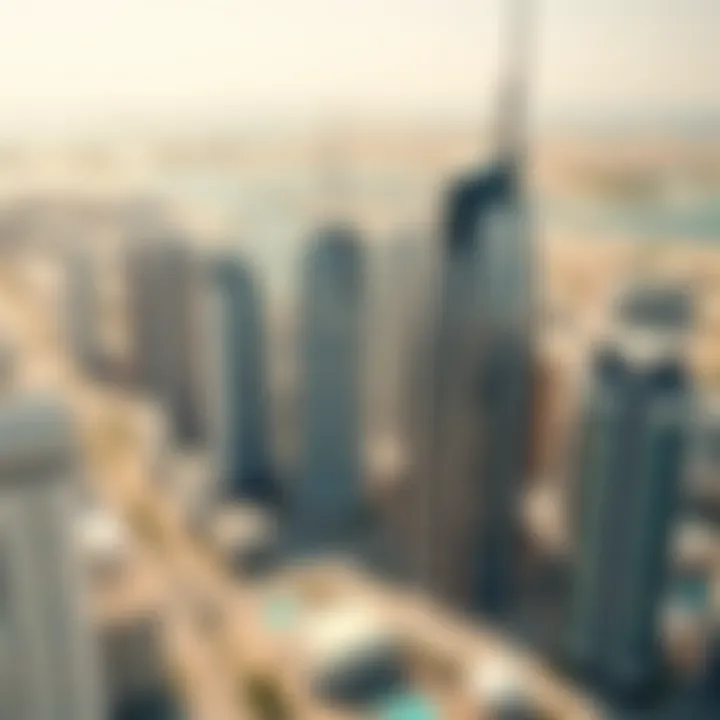
The celebratory blend of cultures brought by globalization also reshapes how architecture is experienced. The interaction between local traditions and contemporary demands push architects to innovate while remaining cognizant of the cultural backdrop. This intertwining of influences makes Dubai a unique study in modern architectural evolution.
"In Dubai, skyscrapers are more than just buildings; they are reflections of the society's aspirations and identity."
Through these lenses, it becomes clear that the construction of skyscrapers is not just about height or grandeur; it's about establishing a dialogue within the urban environment that respects the past while looking towards the future. Investors, architects, and policymakers must consider these vital aspects when embarking on the journey of skyscraper development in Dubai.
In essence, understanding this historical context provides critical insights for stakeholders in the real estate market, enabling them to navigate the dynamic landscape of Dubai's architecture and its ongoing evolution.
Iconic Skyscrapers in Dubai
In a city famous for its astonishing skyline, the iconic skyscrapers of Dubai stand as symbols of ambition and innovation. These towering structures are not just points of interest for tourists; they embody the spirit of a city that thrives on progress and modernity. Each skyscraper tells a unique story, reflecting not only architectural genius but also the economic and social dynamics of this dynamic emirate.
Understanding the significance of these buildings is essential for investors, developers, and anyone looking to engage with Dubai's escalating real estate market. The allure of the skyscrapers often translates to lucrative investment opportunities, drawing stakeholders from across the globe.
Burj Khalifa: A Pinnacle of Modern Design
As the tallest building in the world, the Burj Khalifa epitomizes architectural prowess and ambitious vision. Completed in 2010, this 828-meter giant isn't just an engineering marvel, but also a symbol of Dubai's meteoric rise in global standing. With its unique, triple-lobed footprint inspired by the hymenocallis flower, the design maximizes views and brings a touch of elegance to the city. The building functions as a mixed-use facility housing residential units, corporate suites, and the luxurious Atmosphere restaurant, allowing visitors to experience Dubai from dizzying heights.
The Burj Khalifa attracts millions of tourists annually, boosting local businesses and redefining the hospitality landscape. Its impact on the surrounding area has been profound, catalyzing the establishment of upscale hotels, fine dining eateries, and luxurious shopping malls.
The Address Downtown: Luxury and Innovation
Nestled near the Burj Khalifa, The Address Downtown blends luxury with cutting-edge aesthetics. Standing at 302 meters, it's a landmark that offers an exquisite collection of hospitality and residential units. The hotel features spacious rooms adorned with modern amenities, all aimed at providing the highest level of comfort.
The innovative design embodies Dubai's modern spirit, featuring an infinity pool that overlooks the Burj Khalifa and a stunning blend of outdoor spaces that encourage social interaction. For investors, The Address has set a precedent for high-end hotel developments in the region, showcasing that luxury doesn’t have to compromise quality or sustainability.
Burj Al Arab: Symbol of Opulence
Recognized as one of the most luxurious hotels in the world, the Burj Al Arab is truly a sight to behold. Built on an artificial island, its distinctive sail-shaped silhouette dominates the coastline. The hotel epitomizes indulgence, featuring lavish interiors and dedicated butler services for each guest.
The Burj Al Arab has become synonymous with affluence, often utilized as a benchmark for luxury living and hospitality in Dubai. Its presence has influenced adjacent projects, encouraging other developments to elevate their offerings to meet a discerning clientele's expectations.
Emirates Towers: Business and Aesthetic Excellence
The Emirates Towers consist of two towers: a hotel and an office building, symbolizing the blend of business agility and hospitality in Dubai’s economic ecosystem. The towers rise to heights of 355 and 310 meters, constructed with sleek glass and steel, showcasing modern architectural design.
Prominent businesses consider it a prestigious address, enhancing the brand image of companies that resides there. Additionally, the Towers contribute to the urban fabric of Sheikh Zayed Road, invigorating the business district with a combination of retail and entertainment options, thus enriching the overall experience for both professionals and visitors.
RTA's Dubai Frame: Bridging the Past and Future
The Dubai Frame, often touted as the world's largest picture frame, is a unique structure that connects the past with the present. This iconic landmark stands 150 meters tall and provides panoramic views of old and new Dubai. Its architecture symbolizes the city's ongoing transformation while paying homage to its rich history.
The Frame serves as a heritage site and tourist attraction, where visitors can learn about Dubai's evolution through interactive exhibits. The economic implications are significant, bringing attention to surrounding neighborhoods while fostering a sense of identity among residents.
"The architectural landscape of Dubai is not merely a canvas of marvel, it's a narrative of growth, ambition, and the ethos of a nation aspiring to exceed boundaries."
Through an exploration of these iconic skyscrapers, we gain insight into Dubai's architectural ambitions and their far-reaching impacts—culturally, socially, and economically. Investors and stakeholders are encouraged to pay close attention to these properties, as they represent not only real estate opportunities but also a window into the future of urban living in this vibrant city.
Key Architectural Features
The architectural landscape of Dubai offers a stunning array of skyscrapers that not only serve practical purposes but also redefine urban aesthetics. These towering structures are more than just buildings; they are symbols of ambition, innovation, and cultural expression. In this context, understanding the key architectural features of Dubai's skyscrapers is crucial, as they play an essential role in shaping the identity and functionality of the city.
Innovative Design Techniques
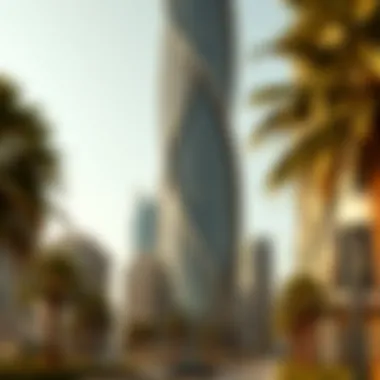
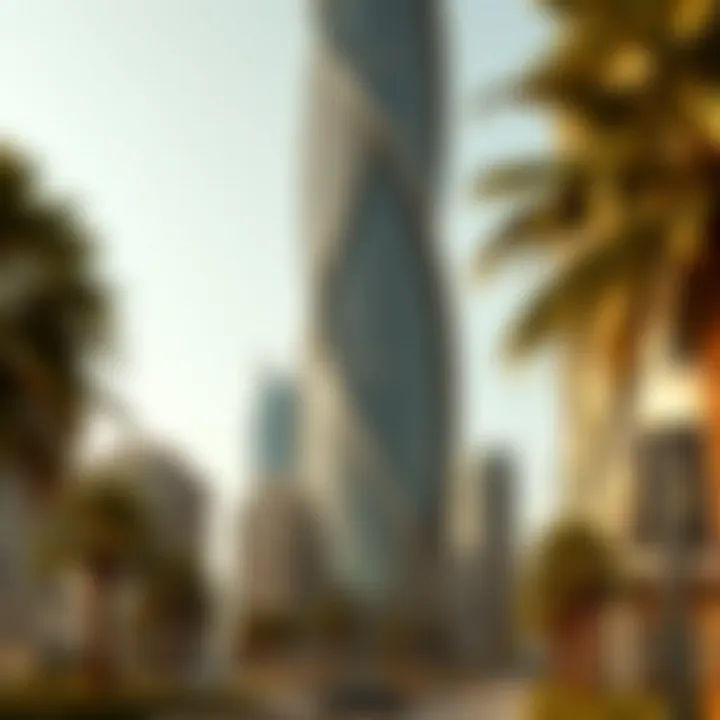
When you wander through Dubai's skyline, it quickly becomes clear that innovation is the name of the game. The design techniques adopted by architects are pushing the envelope. A prominent example is the use of computer-aided design (CAD) and Building Information Modeling (BIM), which allows for complex geometries that were once thought impossible.
- Parametric Design: This technique applies algorithms to generate forms based on set parameters, resulting in unique and often organic shapes. The Ain Dubai, for example, utilizes these methods to create a giant observation wheel that not only looks striking but is also structurally sound.
- Deflection-Controlled Structures: To counteract the stress of strong winds—common in the desert climate—engineers employ materials that can flex without compromising safety. The Burj Khalifa stands tall due to this detail; its reinforced concrete structure is designed to withstand high-pressure winds, showcasing both aesthetic beauty and engineering prowess.
These techniques don't merely serve aesthetic purposes; they enhance the structures' resilience and functionality, making them incredibly efficient spaces for living and working.
Sustainability Practices in Skyscraper Construction
As the world grapples with climate change, Dubai has made notable strides in incorporating sustainable practices within its architectural processes. Skyscrapers not only consume resources but also have the potential to conserve. Here are key practices adopted in Dubai that shine a spotlight on sustainability:
- Energy-Efficient Systems: Skyscrapers like the One Za'abeel utilize cutting-edge technologies such as high-performance glass facades and energy-efficient HVAC systems, reducing their ecological footprint.
- Water Reduction Methods: Greywater recycling systems are gaining traction. This practice takes wastewater from homes and businesses and treats it for non-potable uses, significantly conserving precious water resources in a desert environment.
- Green Roofs and Vertical Gardens: Integrating vegetation within these vertical structures promotes biodiversity and improves air quality. The Emirates Towers, with their carefully planned garden spaces, offer a fresh breath of air against the urban backdrop.
In essence, these sustainability measures reflect a conscious effort to harmonize architectural splendor with ecological responsibility.
"Dubai's skyscrapers are not just monuments; they are powerful statements about the possibilities of modern architecture while keeping an eye on the planet's well-being."
Overall, the intricate architectural features of Dubai's skyscrapers illuminate a steadfast commitment to innovation, efficiency, and sustainability, providing invaluable insights for real estate investors, developers, and urban planners looking towards future trends.
Economic Impact of Skyscrapers
The skyline of Dubai is not just a testament to architectural ingenuity; it’s also a barometer of economic progress. Skyscrapers have become cornerstones of Dubai’s economy, influencing various sectors—real estate, tourism, and business alike. Their presence has elevated the city into a global metropolis and transformed its economic landscape. Understanding this impact is crucial, especially for investors, real estate agents, and developers, who seek insights into how these towering structures can shape market dynamics and opportunities.
Contribution to Real Estate Market
Dubai's real estate market has enjoyed significant growth due to its iconic skyscrapers. These structures, often viewed as luxury investments, attract both local and international buyers. A notable example is the Burj Khalifa, which stands not just as a tourist attraction, but also offers premium residential options. High demand from international investors bolsters property prices, making residential units in these buildings valuable commodities.
- High-Rise Living: The allure of living in towering structures allows developers to command higher prices for limited land availability. Residents enjoy unparalleled views, luxury amenities, and proximity to business districts.
- Commercial Spaces: Skyscrapers house major corporations and multinational companies. For instance, the Emirates Towers stand as a significant business hub, drawing finance and tech firms that seek prestigious addresses.
- Investment Potential: With increasing foreign interest, the resale value of properties in iconic skyscrapers remains high, making these investments attractive to buyers looking for long-term returns.
The enhancements in infrastructure and services around these skyscrapers further augment their appeal. Connectivity with public transport and recreational zones boosts land value in adjacent areas, creating ancillary growth in the real estate market.
Tourism and Business Opportunities
Skyscrapers are monumental in shaping tourism and creating a vibrant business atmosphere. The architectural grandeur of buildings like the Burj Al Arab generates waves of visitors keen to experience luxury. This influx contributes invaluable revenue not only to the hotels but also to surrounding businesses, such as restaurants, shops, and entertainment venues.
- Tourist Magnet: Tourists flock to Dubai primarily for its iconic skyline, often leading to extended stays at nearby hotels. The view from the top of the Burj Khalifa offers just one of many reasons visitors consider Dubai a must-see destination.
- Business Events: High-rise buildings frequently host international conferences and business events. The Address Downtown, for example, provides a luxurious and convenient setting for corporate gatherings, further establishing Dubai as a hub for global commerce.
- Cultural Hubs: Skyscrapers become cultural landmarks and social spaces. Initiatives that involve art exhibitions in lobby areas or public spaces ignite interest, drawing in crowds and fostering community engagement.
The synergy between skyscrapers and their economic impact is profound. Their ability to generate business and attract tourists essentially positions Dubai as a global player in urban development.
Future Trends and Innovations
As we look ahead, the skyscrapers of Dubai stand on the brink of transformation. With the ever-increasing push for sustainability, efficiency, and technological integration in urban design, the future trends and innovations shaping Dubai’s skyline not only reflect architectural beauty but also hint at how cities will function in the future.
Emerging Technologies in Skyscraper Design
The implementation of emerging technologies in skyscraper design is pivotal. Architects and engineers are enthusiastically exploring avant-garde tools that streamline the building process and enhance the overall occupant experience.
One of the most significant advancements is the use of Building Information Modeling (BIM). This technology allows for a 3D visualization of structures during the planning phase, significantly reducing construction errors. Another fascinating trend is the integration of robotics in construction. Companies are deploying drones and robotic arms to carry out tasks that were once labor-intensive, such as bricklaying or inspections, which speed up the process and improve safety.
Moreover, advanced materials like self-healing concrete and glass that can change opacity have emerged. Self-healing concrete, for instance, repairs its cracks autonomously, extending a building’s life and reducing maintenance costs. These innovations contribute not just to aesthetics but also to structural durability.
"In the world of skyscrapers, it’s not only about climbing higher but also about building smarter."


Additionally, smart façade technologies allow buildings to adapt to changing weather conditions, improving energy efficiency. Automated shading systems can respond to sunlight, reducing cooling costs in sweltering temperatures. These features are vital in maintaining comfort levels in Dubai’s extreme heat, representing a blend of innovation and necessity.
The Role of Smart Cities in Shaping Future Developments
The concept of smart cities is rapidly taking center stage, especially in a city like Dubai, which thrives on innovation. Smart city initiatives foster interconnectivity among structures, where skyscrapers do not exist in isolation but function as parts of a larger ecosystem.
Dubai aims to incorporate the Internet of Things (IoT) into urban development. From intelligent traffic management systems to real-time energy consumption tracking, skyscrapers are expected to contribute to a more synchronized urban environment. Sensors embedded within buildings can monitor their structural health and alert management of any issues, ensuring safety and prolonging lifespan.
Furthermore, smart cities focus on sustainable practices. Green roofs, vertical gardens, and renewable energy sources like solar panels are becoming integral aspects of skyscraper designs in Dubai. This not only enhances building aesthetics but also promotes biodiversity within an urban context.
As Dubai continues its trajectory as a global business hub, the integration of smart city principles into skyscraper development will play a significant role in attracting international investments. Investors are looking closely at how future developments will align with sustainable practices and technological advancements, ensuring their portfolio remains robust in an evolving marketplace.
Challenges in Skyscraper Construction
The construction of skyscrapers in Dubai brings with it a unique set of challenges that can impact not only the building process but also the larger urban fabric. As developers and architects plot ambitious projects that reach for the heavens, navigating these hurdles becomes paramount. Addressing the challenges of skyscraper construction is not just about overcoming obstacles; it’s also about understanding their implications on efficiency, safety, and aesthetics. By unpacking these elements, stakeholders can glean valuable insights that support their investment decisions and shape a sustainable architectural future.
Regulatory and Legal Considerations
When constructing skyscrapers, regulatory and legal frameworks play a crucial role. In Dubai, the rapid pace of development has prompted authorities to establish a robust legal framework to ensure safety, compliance, and quality. This regulatory environment is essential for maintaining the integrity of the skyline and ensuring the welfare of the public.
Important regulations include:
- Building Codes: Compliance with local building codes is essential. These codes dictate everything from structural safety to fire prevention measures. In a city where towering edifices scrape the clouds, even minor infractions can lead to catastrophic consequences.
- Zoning Laws: These laws determine the permitted uses for various plots of land. In Dubai, a keen understanding of zoning regulations is necessary to avoid costly mishaps.
- Environmental Assessments: Developers must conduct thorough environmental assessments to evaluate potential impact on local ecosystems and habitats. This is not just a legal requirement; it builds goodwill and trust with the public.
- Historical Preservation Laws: As Dubai continues to modernize, the balance between innovation and heritage preservation is critical. Compliance with laws protecting historical sites can shape the design and placement of new skyscrapers.
Understanding this legal framework helps investors, architects, and construction managers to remain compliant and avoid expensive delays or modifications.
Environmental and Social Impacts
The construction of skyscrapers has profound environmental and social implications, which must be factored into every stage of the building process. These impacts can be categorized into several critical dimensions:
- Resource Consumption: Sky-high structures often require vast quantities of resources such as steel and concrete. This can result in significant environmental degradation if not managed responsibly. Sustainable practices can mitigate these impacts, but careful planning is essential.
- Carbon Footprint: The energy consumption during construction and operation of skyscrapers contributes substantially to emissions. Placing emphasis on energy-efficient designs and renewable energy sources can lessen the carbon footprint.
- Social Displacement: As new skyscrapers go up, existing communities may be uprooted. This can lead to social tensions and pushback from residents who feel neglected by rapid urbanization. Addressing these concerns is vital for maintaining social harmony and fostering public support.
- Water and Air Quality: Construction activities can temporarily degrade local water and air quality. Strict adherence to environmental standards is crucial in protecting the health of nearby residents.
To summarize, the challenges found in skyscraper construction are not merely technical; they are also deeply intertwined with legal, environmental, and social facets. Navigating these issues skillfully can set the stage for a successful project that aligns with Dubai’s vision as a leader in innovation and sustainability.
"In the world of skyscrapers, every challenge presents an opportunity to redefine standards and achieve greater heights."
By addressing these challenges head-on, investors and developers can find ways to turn potential pitfalls into stepping stones towards success.
End
The towering skyscrapers of Dubai do more than just scrape the sky; they represent an intricate narrative of human ambition, technological prowess, and cultural evolution. In assessing the impact of these architectural marvels, it's vital to consider their contributions not only as physical structures but as catalysts of economic and social transformation for the city.
The Future of Skyscrapers in Dubai
Dubai's skyline is continually evolving, mirroring the aspirations of a city that thrives on innovation. Future projects are likely to incorporate sustainable design principles, integrating eco-friendly materials and energy-efficient technologies. For instance, developers are already looking into vertical gardens and smart technology to manage resources more effectively. Such advancements cater to the growing concern for environmental impact while meeting the demands of an ever-expanding urban population.
Furthermore, upcoming skyscrapers will likely embrace mixed-use functionality, combining residential, commercial, and recreational spaces within the same structure. This trend not only optimizes land use but also nurtures vibrant communities, enhancing both the quality of life for residents and the overall appeal of Dubai as a global destination.
As the concept of smart cities gains traction, we can expect future developments in Dubai to leverage data and connectivity, transforming the way inhabitants interact with their built environments. With ongoing investments in digital infrastructure, skyscrapers will become integral parts of a high-tech ecosystem, promoting seamless integration between buildings and urban spaces.
"In the coming decades, Dubai's skyline won’t just be a reflection of its past but a blueprint for the future—a fusion of tradition, innovation, and sustainability."
Final Thoughts on Architectural Identity
The architectural identity of Dubai is a melting pot of influences; it draws from various cultures while also projecting a future-oriented vision. This unique identity is crafted through its skyscrapers, each telling a story that resonates with the values and aspirations of the emirate.
As investors, developers, and urban planners keenly observe these architectural trends, it’s essential to align new projects with the city's vision. Understanding the historical context, recognizing the impact of global architectural movements, and embracing local traditions will enrich Dubai's built environment. This isn’t just about erecting tall buildings; it’s about creating spaces that foster interaction, support economic growth, and reflect the spirit of innovation.
Ultimately, as the city continues to evolve, so too will its identity. The skyscrapers of Dubai will remain not just as symbols of modernization but as testaments to the blend of human ingenuity, cultural narrative, and communal aspirations, setting the stage for future architectural endeavors.



